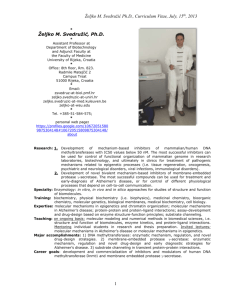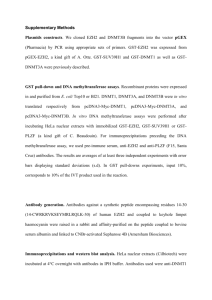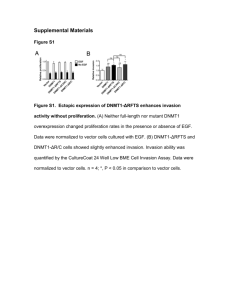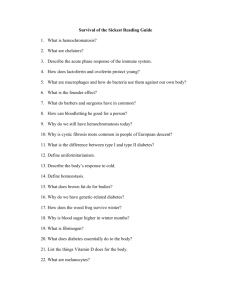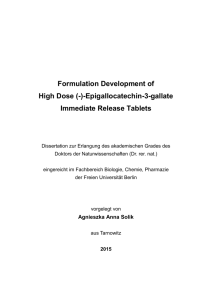Identification of Kazinol Q, a Natural Product from Formosan Plants
advertisement
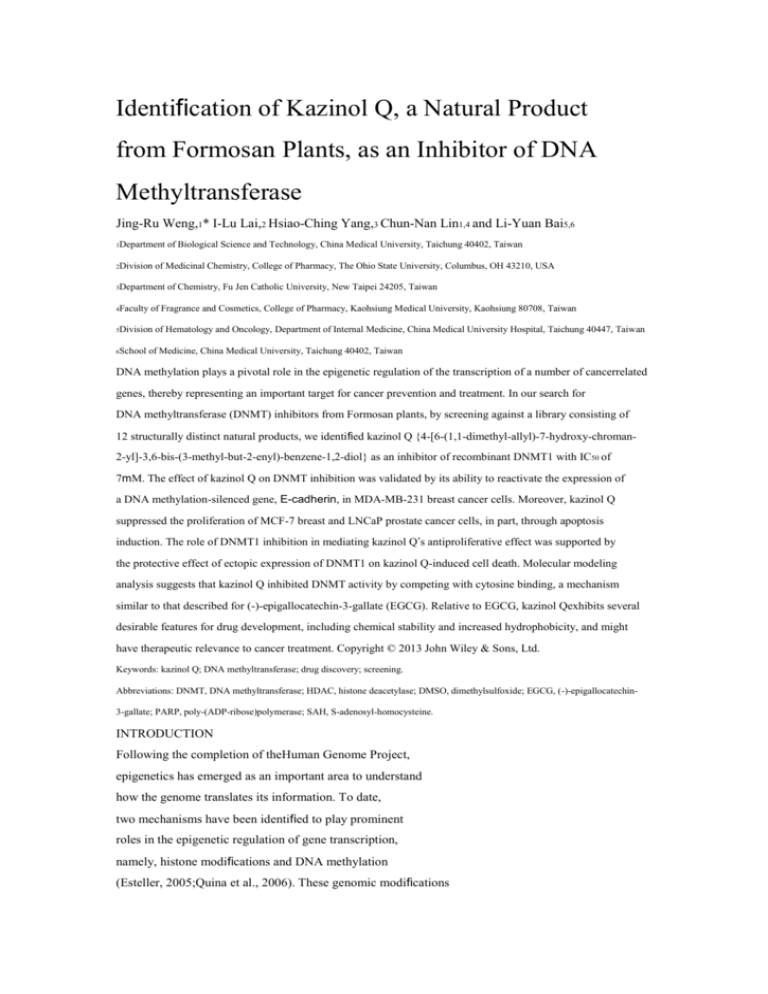
Identification of Kazinol Q, a Natural Product
from Formosan Plants, as an Inhibitor of DNA
Methyltransferase
Jing-Ru Weng,1* I-Lu Lai,2 Hsiao-Ching Yang,3 Chun-Nan Lin1,4 and Li-Yuan Bai5,6
1Department
2Division
of Medicinal Chemistry, College of Pharmacy, The Ohio State University, Columbus, OH 43210, USA
3Department
4Faculty
of Chemistry, Fu Jen Catholic University, New Taipei 24205, Taiwan
of Fragrance and Cosmetics, College of Pharmacy, Kaohsiung Medical University, Kaohsiung 80708, Taiwan
5Division
6School
of Biological Science and Technology, China Medical University, Taichung 40402, Taiwan
of Hematology and Oncology, Department of Internal Medicine, China Medical University Hospital, Taichung 40447, Taiwan
of Medicine, China Medical University, Taichung 40402, Taiwan
DNA methylation plays a pivotal role in the epigenetic regulation of the transcription of a number of cancerrelated
genes, thereby representing an important target for cancer prevention and treatment. In our search for
DNA methyltransferase (DNMT) inhibitors from Formosan plants, by screening against a library consisting of
12 structurally distinct natural products, we identified kazinol Q {4-[6-(1,1-dimethyl-allyl)-7-hydroxy-chroman2-yl]-3,6-bis-(3-methyl-but-2-enyl)-benzene-1,2-diol} as an inhibitor of recombinant DNMT1 with IC50 of
7mM. The effect of kazinol Q on DNMT inhibition was validated by its ability to reactivate the expression of
a DNA methylation-silenced gene, E-cadherin, in MDA-MB-231 breast cancer cells. Moreover, kazinol Q
suppressed the proliferation of MCF-7 breast and LNCaP prostate cancer cells, in part, through apoptosis
induction. The role of DNMT1 inhibition in mediating kazinol Q’s antiproliferative effect was supported by
the protective effect of ectopic expression of DNMT1 on kazinol Q-induced cell death. Molecular modeling
analysis suggests that kazinol Q inhibited DNMT activity by competing with cytosine binding, a mechanism
similar to that described for (-)-epigallocatechin-3-gallate (EGCG). Relative to EGCG, kazinol Qexhibits several
desirable features for drug development, including chemical stability and increased hydrophobicity, and might
have therapeutic relevance to cancer treatment. Copyright © 2013 John Wiley & Sons, Ltd.
Keywords: kazinol Q; DNA methyltransferase; drug discovery; screening.
Abbreviations: DNMT, DNA methyltransferase; HDAC, histone deacetylase; DMSO, dimethylsulfoxide; EGCG, (-)-epigallocatechin3-gallate; PARP, poly-(ADP-ribose)polymerase; SAH, S-adenosyl-homocysteine.
INTRODUCTION
Following the completion of theHuman Genome Project,
epigenetics has emerged as an important area to understand
how the genome translates its information. To date,
two mechanisms have been identified to play prominent
roles in the epigenetic regulation of gene transcription,
namely, histone modifications and DNA methylation
(Esteller, 2005;Quina et al., 2006). These genomic modifications
affect patterns of genetic regulation without
altering the nucleotide sequence of the underlying
DNA, and are inheritable from one cell generation to
the next (Biel et al., 2005). Moreover, these dynamic
processes provide a mechanism by which an organism
can respond to environmental signals through changes
in gene expression during cell growth and differentiation
(Jaenisch and Bird, 2003). Accumulating evidence indicates
that dysregulation of these epigenetic processes
causes transcriptional repression (or silencing) of a subset
of genes, which underlies the pathogenesis of many
human diseases. In the past decade, substantial progress
has beenmade in understanding the causative relationship
between aberrant epigenetic changes and tumorigenesis
(Jones, 2005; Laird, 2005; Moggs et al., 2004; Momparler,
2003), which has led to the human clinical trials of histone
deacetylase (HDAC) inhibitors and, to a lesser extent,
DNA methylation inhibitors in solid tumors and hematological
malignancies.
DNA methylation inhibitors can be classified into two
categories: nucleoside inhibitors and non-nucleoside
inhibitors (Fig. 1) (Goffin and Eisenhauer, 2002; Lyko
and Brown, 2005; Yoo and Jones, 2006). Nucleoside
inhibitors, such as 5-azacytidine, 5-aza-2’-deoxycytidine
(decitabine), and zebularine, are often associated with
substantial toxic effects and short half-lives in aqueous
solutions (Lyko and Brown, 2005). To date, there are only
a limited number of non-nucleoside inhibitors of DNA
methylation described in the literature, which include
procainamide (Lee et al., 2005), (-)-epigallocatechin-3gallate (EGCG) (Fang et al., 2003), psammaplins (Pina
et al., 2003), hydralazine (Cornacchia et al., 1988;
Segura-Pacheco et al., 2003; Zambrano et al., 2005), and
RG108 (Brueckner et al., 2005). Among them, RG108,
EGCG, and psammaplins mediate the inhibition of
DNA methylation by binding to the catalytic pocket of
human DNA methyltransferase (DNMT), while the
* Correspondence to: Jing-Ru Weng, Ph.D, Department of Biological
Science and Technology, China Medical University, 91 Hsueh-Shih Road,
Taichung 40402, Taiwan.
E-mail: columnster@gmail.com
PHYTOTHERAPY RESEARCH
Phytother. Res. (2013)
Published online in Wiley Online Library
(wileyonlinelibrary.com) DOI: 10.1002/ptr.4955
Copyright © 2013 John Wiley & Sons, Ltd.
Received 06 June 2012
Revised 14 January 2013
Accepted 25 January 2013
mode of mechanism of other inhibitors remains unclear.
In light of the potential of DNMT as a therapeutic target,
there is an urgent need to identify novel non-nucleoside
DNMT inhibitors for clinical development. Previously,
we reported the isolation of a series of natural products
fromFormosan plants,which exhibit interesting antitumor
and antiplatelet activities (Chung et al., 1993; Chung et al.,
1997; Day et al., 1999; Gan et al., 1998; Ko et al., 1999; Ko
et al., 1997; Weng et al., 2006). In the present study, we
characterized the abilities of 12 representative agents to
inhibit DNMT activity, which led to the identification of
kazinol Q {4-[6-(1,1-dimethyl-allyl)-7-hydroxy-chroman2-yl]-3,6-bis-(3-methyl-but-2-enyl)-benzene-1,2-diol} as a
DNMT inhibitor with mM potency.
MATERIALS AND METHODS
Compound library and reagents. Compounds 1 – 12 were
isolated from various Formosan plant sources as previously
described (Chung et al., 1993; Chung et al., 1997;
Day et al., 1999; Gan et al., 1998; Ko et al., 1999; Ko
et al., 1997; Weng et al., 2006). EGCG, poly(dI-dC)•poly
(dI-dC), and rabbit polyclonal antibodies against b-actin
were purchased from Sigma-Aldrich (St. Louis, MO).
Recombinant DNMT1 and S-adenosyl-L-[methyl-3H]
methionine were obtained from New England Biolabs
(Ipswich, MA) and Amersham (Piscataway, NJ), respectively.
Rabbit polyclonal anti-E-cadherin antibodies and
mouse monoclonal anti-poly-(ADP-ribose)polymerase
(PARP) antibody were purchased from Cell Signaling
Technologies (Beverly,MA) and Pharmingen (San Diego,
CA), respectively. The enhanced chemiluminescence
(ECL) system for detection of immunoblotted proteins
was from GE Healthcare Bioscience (Piscataway, NJ).
Other chemicals and biochemistry reagents were obtained
from Sigma–Aldrich unless otherwise mentioned.
Cell culture. LNCaP prostate and MCF-7 and MDAMB231 breast cancer cells were purchased from the
American Type Tissue Collection (Manassas, VA) and
cultured in RPMI 1640 and Dulbecco’s minimal essential
medium/Ham’s F12 (DMEM/F12; 1:1) (Gibco, Grand
Island, NY), respectively, supplemented with 10% fetal
bovine serum (FBS; Gibco). All cell types were cultured
at 37 _C in a humidified incubator containing 5% CO2.
DNMT assays. Cultured LNCaP cells were harvested,
and nuclear extracts were prepared with the nuclear
extraction reagent (Pierce, Rockford, IL). The DNMT
assay was performed according to a published method
(Belinsky et al., 1996). The isolated nuclear extracts
(1.28 mg of protein) were incubated with 0.5 mM poly
(dI-dC)•poly(dI-dC) (Sigma, St. Louis, MO) and 10 mM
S-adenosyl-L-[methyl-3H]methionine (1 mCi; Amersham,
Piscataway, NJ) in a total volume of 20 ml of a DNMT
buffer solution (New England, Biolabs Inc.) in the
presence of the test agent in indicated concentrations at
37 _C for 3 h. The reaction was initiated by the addition
of S-adenosyl-L-[methyl-3H] methionine and stopped
by loading into mini-columns (Spin-50, USA Scientific)
and centrifuged for 3 min. The radioactivity of
resulting solutions was counted in a scintillation counter.
All of the assays were performed in duplicate. Background
levels were determined in incubations without
the nuclear extracts.
Effect of kazinol Q on cancer cell proliferation. LNCaP
and MCF-7 cells were seeded into six-well plates at
approximately 200,000 cells/well in 10% FBS-containing
medium. Following a 24 h attachment period, cells were
treated in triplicate with the indicated concentrations of
test agent or DMSO vehicle in 10% FBS-containing
medium. At different time intervals, cells were harvested
by trypsinization, and numerated using a Coulter counter
(Model Z1 D/T, Beckman Coulter, Fullerton, CA).
Apoptosis analysis. Drug-induced apoptotic cell death
was assessed by Western blot analysis of caspase-3
activation and PARP cleavage. Drug-treated cells were
collected after 48 h of treatment, washed with ice-cold
PBS, and resuspended in lysis buffer containing 20mM
Tris-HCl, pH8, 137mM NaCl, 1mM CaCl2, 10%
glycerol, 1% Nonidet P-40, 0.5% deoxycholate, 0.1%
SDS, 100 mM 4-(2-aminoethyl)benzenesulfonyl fluoride,
leupeptin at 10 mg/mL, and aprotinin at 10 mg/mL.
Soluble cell lysates were collected after centrifugation
at 10,000 g for 5min. Equivalent amounts of proteins
(60–100 mg) from each lysate were resolved in 8%
SDS-polyacrylamide gels. Proteins were transferred to
nitrocellulose membranes and analyzed by immunoblotting
with antibodies against caspase-3 or PARP as
described below.
Immunoblotting. Treated cells were washed in PBS,
resuspended in SDS sample buffer, sonicated for 5 s, and
then boiled for 5 min. After brief centrifugation, equivalent
amounts of proteins from the soluble fractions of cell
lysates were resolved in 10%SDS-polyacrylamide gels on
a Minigel apparatus, and transferred to a nitrocellulose
membrane using a semi-dry transfer cell. The transblotted
membrane was washed three times with TBS containing
0.05% Tween 20 (TBST). After blocking with TBST
containing 5% nonfat milk for 60min, the membrane
was incubated with an appropriate primary antibody at
1:500 dilution (with the exception of anti-b-actin antibody,
1:2000) in TBST-5%low fat milk at 4 _C for 12 h, and was
then washed three times with TBST. The membrane was
probed with goat anti-rabbit or anti-mouse IgG-horseradish
peroxidase conjugates (1:2500) for 90 min at room
temperature, and washed three times with TBST. The
immunoblots were visualized by ECL.
Ectopic expression of DNMT1 in MCF-7 cells. Transfection
of MCF-7 cells with a full-length DNMT1 plasmid
(pLZRS-DNMT1; Addgene, Cambridge, MA) or
Figure 1. Structures of existing DNA methylation inhibitors.
J.-R. WENG ET AL.
Copyright © 2013 John Wiley & Sons, Ltd. Phytother. Res. (2013)
pCMV vector was performed by electroporation using
Nucleofector kit R of the Amaxa Nucleofector system
(Lonza, Walkersville, MD) according to the manufacturer’s
protocol.
Flow cytometric analysis of reactive oxygen species (ROS)
production. ROS was detected using the fluorescence
probe 5-(and-6)-carboxy-2’,7’-dichloro-dihydrofluorescein
diacetate as described (Bai et al., 2011). Data were
analyzed by ModFitLT V3.0 software program.
Human DNMT1 homology modeling. The homology
model of the human DNMT1 catalytic domain was built
with the crystal structure of the bacterial modification
methylase (Hhal) catalytic domain (PDB ID 4MHT)
as the modeling template. The 478 amino acids (AA
1139-1616) of DNMT1 were aligned against the 327
residue of the Hhal methylase catalytic domain by a
combination of CLUSTALW and Smith–Waterman
methods (Scheme 1). As shown, the N- and C-terminal
sequences align well with the template, and the middle
sequence has little homology between the two proteins.
The two aligned regionsweremodeled usingMODELLER
v8 (Sali and Blundell, 1993). The resulting structure was
minimized together with cofactor S-adenosyl-homocysteine
(SAH) and flipped cytosine substrate plus 15Å truncated
octahedron TIP3P water box.
Molecular docking. For kazinol Q, all hydrogens were
added, and Gasteiger charges were assigned (Gasteiger
and Marsili, 1980), then non-polar hydrogens were
merged. Eighty_100_70 3-D affinity grids centered
on the empty binding site with 0.375Å spacing were
calculated for each of the following atomtypes: a) protein:
A (aromatic C), C, HD, N, NA, OA, SA; b) ligand: C, A,
OA, HD, e (electrostatic) and d (desolvation) using
Autogrid4 (Huey et al., 2007). AutoDock version 4.0.0
(Huey et al., 2007) was used for the docking simulation.
We selected the Lamarckian genetic algorithm (LGA)
for ligand conformational searching because it has
enhanced performance relative to simulated annealing
or the simple genetic algorithm. The ligand’s translation,
rotation, and internal torsions are defined as its state
variables, and each gene represents a state variable.
LGA adds local minimization to the genetic algorithm,
enabling modification of the gene population. The
docking parameterswere as follows: trials of 100 dockings,
population size of 250, random starting position and
conformation, translation step ranges of 2.0 Å, rotation
step ranges of 50_, elitism of 1, mutation rate of 0.02,
crossover rate of 0.8, local search rate of 0.06, and 100
million energy evaluations. Final docked conformations
were clustered using a tolerance of 1.5Å root-meansquare
deviations.
RESULTS AND DISCUSSION
Small diverse molecular library
A small library consisting of 12 purified, structurally
distinct natural products fromour lab was used to identify
compounds with inhibitory activity against recombinant
DNMT1 (Chung et al., 1993; Chung et al., 1997; Day
et al., 1999; Gan et al., 1998; Ko et al., 1999; Ko et al.,
1997; Weng et al., 2006). These compounds included
gemichalcone A (1) (Chung et al., 1997), 3a-acetoxy-5alanosta8,24-dien-21-oic acid ester b-D-glucoside (2)
(Gan et al., 1998), frangulin B (3) (Chung et al.,
1993), justicidin A (4) (Day et al., 1999), morusin (5)
(Ko et al., 1997), kazinol Q (6)(Ko et al., 1999),
artochamin B (7) (Weng et al., 2006), artomin D (8)
(Weng et al., 2006), cyclocomunomethonol (9) (Weng
et al., 2006), artomunoflavanone (10) (Weng et al.,
2006), artomunoisoxanthone (11) (Weng et al., 2006),
and artocommunol CC (12) (Weng et al., 2006) (Fig. 2A).
Screening
In the screening of DNMT inhibitors, the ability of
individual compounds from Formosan plants vis-à-vis
the positive control EGCG, each at 10 mM, to block
the recombinant DNMT1-mediated transfer of tritiumlabeled
methyl function from S-adenosyl-(3H-methyl)L-methionine to poly(dI-dC)•poly(dI-dC) was monitored
(Fig. 2). Among the 12 compounds examined, compound
Scheme 1. Homology modeling of DNMT1
Figure 2. Structures of compounds 1 – 12 (A), and the relative
activities of 10 mM individual compounds vis-à-vis EGCG, each at
10 mM, compared to the DMSO control in inhibiting recombinant
DNMT1 activity (B). Each data point represents mean_S.D.
(n=3).
IDENTIFICATION OF KAZINOL AS A NOVEL DNA METHYLTRANSFERASE INHIBITOR
Copyright © 2013 John Wiley & Sons, Ltd. Phytother. Res. (2013)
6 (kazinol Q) exhibited a significant effect on DNMT1 inhibition,
while others showed no apparent inhibitory
activities. Further examinations at different doses of
kazinol Q versus EGCG revealed a dose-dependent
inhibition of recombinant DNMT1 activity, with IC 50 of
7 mM and 3mM, respectively (Fig. 3A). Previously, the
IC50 ofEGCGwas reported to be 20 mM, which, however,
was based on the nuclear extract of esophageal squamous
cells as the enzyme source (Fang et al., 2003).
To validate the inhibition of DNMT, we investigated
the effect of kazinol Q vis-à-vis EGCG and 5-aza-2’deoxycytidine (decitabine) on the expression of
E-cadherin in MDA-MB-231 breast cancer cells by
Western blotting. Evidence indicates that expression of
E-cadherin is silenced in MDA-MB-231 cells due to
aberrant 5’CpG island methylation (Nass et al., 2000),
and that the silenced E-cadherin gene (CDH1) could
be reactivated by 5-aza-2’-deoxycytidine (Graff et al.,
1995). Exposure of MDA-MB-231 cells to kazinol Q
and 5-aza-2’-deoxycytidine for 48 h culminated in a
dose-dependent increase in E-cadherin expression,
which, however, was not noted with EGCG (Fig. 3B).
This finding is consistent with the reported chemical
instability of EGCG in culture medium (half-life, 130min)
as a result of auto-oxidation (Naasani et al., 2003).
Consequently, spontaneous degradation might
account for EGCG’s lack of potency in reactivating
E-cadherin expression.
Furthermore, the antiproliferative effect of kazinol Q
was examined in LNCaP prostate cancer and MCF-7
cells in 10% FBS-supplemented medium (Fig. 4A). As
shown, the IC50 in inhibiting cell proliferation was
approximately 2 mM for both cell lines. This antitumor
activity was, at least in part, attributable to apoptosis
as evidenced by PARP cleavage by Western blot
analysis (Fig. 4B).
Figure 3. Identification of kazinol Q as a DNMT inhibitor. (A) Dose–
response curves of kazinol Q and EGCG in inhibiting the activity of
recombinant DMNT1 (n=3). (B) Western blot analysis of the
dose-dependent effects of kazinol Q, EGCG, and 5-aza-2’deoxycytidine on up-regulating E-cadherin expression in 5% FBSsupplementedmediuminMDAMB-231 cells after 48h of treatment.
Controls received DMSO vehicle.
Figure 4. Effects of kazinol Q on the survival of LNCaP and MCF-7 cells. (A) Antiproliferative effect of kazinol Q at 1, 2,
5, and 10 mM in 10%
FBS-supplemented medium in LNCaP and MCF-7 cells. Each data point represents mean_S.D. (n=3). (B) PARP
cleavage in kazinol Q-treated
MCF-7 cells. PARP proteolysis to the apoptosis-specific 85-kDa fragment was monitored by Western blotting after 48
h of treatment.
J.-R. WENG ET AL.
Copyright © 2013 John Wiley & Sons, Ltd. Phytother. Res. (2013)
Evidence that DNMT1 inhibition and ROS underlies
the antiproliferative effect of kazinol Q
To shed light onto the role of DNMT1 inhibition in
kazinol Q-mediated inhibition of cell proliferation, we
assessed the effect of ectopic expression of DNMT1 on
the viability of kazinol Q-treated MCF-7 cells. MCF-7
cells were transiently transfected with a DNMT1 plasmid
or pCMV control vector. As shown, increased
DNMT1 expression provided a partial protection
against the suppressive effect of kazinolQon cell viability
(*P<0.05; Fig. 5A). Moreover, in light of a recent
report that kazinol Q induced ROS-dependent cell
death in gastric cancer cells (Wei et al., 2011), we investigated
the effect of kazinol Q on ROS production in
MCF-7 cells (Fig. 5B). Flow cytometric analysis
confirmed the accumulation of ROS in response to the
treatment of kazinol Q (10 mM), suggesting the pleiotropic
mode of action of kazinol Q in mediating its
antiproliferative activity.
Validation and characterization
In light of the largely shared structural motif (i.e., the
hydroxylated 2-phenyl-chroman nucleus), kazinol Q
and EGCG might exhibit a similar mode of binding to
the catalytic site of DNMT1. To envisage the ligand–
protein interaction, we used the crystal structure of the
bacterial homologue Hhal methyltransferase (Nass et al.,
2000) (PDB entry code, 4MHT) as a template to carry
out homology modeling of the human DNMT1 catalytic
domain. The resulting structure was energy-minimized
in complex with its cofactor SAH.
Docking of kazinol Q into the modeled DNMT1
catalytic site suggests that kazinol Q inhibited DNMT
activity by competing with cytosine binding, a mechanism
similar to that described for EGCG (Fang et al., 2003).
However, despite shared structural motifs, kazinol Q
exhibited a somewhat different mode of protein–ligand
interactions from that of EGCG (Fang et al., 2003),
in part, due to the absence of the galloyl moiety and
Figure 5. (A) Protective effect of ectopic expression of DNMT1 on kazinol Q-mediated suppression of the viability of
MCF-7 cells. Left,
Western blot analysis of the expression level of DNMT1 in MCF-7 cells transiently transfected with a DNMT1 plasmid
versus that with a
pCMV control vector. Right, MTTanalysis of the dose-dependent effect of kazinol Q on the viability in MCF-7 cells
transfected with a DNMT1
plasmid versus a pCMV vector after 72 h of treatment. Each data point represents mean_S.D. (n=6). (B) Flow
cytometric analysis of ROS
production in MCF-7 cells treated with 10 mM kazinol Q versus DMSO control for 72 h. Values, means+SD (n=3).
Figure 6. Modeled docking of kazinol Q into the cytosine-binding
site of DNMT1. (A) Consensus orientation of kazinol Q in the
cytosine-binding domain. Protein structure is depicted in ribbon
representation and colored by secondary structures (helix, strand,
and loop). Ligand contact residues are represented in stick form
and colored by atom type with carbon in gray, oxygen in red, and
hydrogen in green. (B) Diagrammatic presentation of the interactions
between kazinol Q and the cytosine-binding site. Dashed lines
represent hydrogen bonds. This figure is available in colour online
at wileyonlinelibrary.com/journal/ptr.
IDENTIFICATION OF KAZINOL AS A NOVEL DNA METHYLTRANSFERASE INHIBITOR
Copyright © 2013 John Wiley & Sons, Ltd. Phytother. Res. (2013)
differences in the hydrophobicity of the core structure.
The driving force for kazinol Q binding was the insertion
of the phenyl ring into the cytosine-binding pocket
(Fig. 6A and B).
In addition to hydrophobic interactions with the
isoprenyl function, Glu1265, Arg1309, and Arg1311
were positioned to form hydrogen bonds with the two
hydroxyl groups. Relatively, the chroman moiety played
a lesser role in protein binding, contributing to a hydrogen
bond with Gln1226, reminiscent to that of EGCG. However,
due to lack of a galloyl moiety, kazinol Q displayed
a lower degree of hydrogen bonding with the cytosinebinding
site, which might underlie its lower potency in
DNMTinhibition as compared to EGCG (7 versus 3 mM).
In summary, this study identifies kazinol Q as a novel
DNMT inhibitor by screening against a small natural
product-based chemical diversity library from our
previous studies (Chung et al., 1993; Chung et al., 1997;
Day et al., 1999; Gan et al., 1998; Ko et al., 1999; Ko
et al., 1997; Weng et al., 2006), which was demonstrated
by its ability to inhibit DNMT1 activity and to
upregulate E-cadherin expression in breast cancer cells.
Relative to EGCG, kazinol Q exhibits several desirable
features for drug development, including chemical
stability and increased hydrophobicity for improved
pharmacokinetic behaviors.Moreover, kazinolQexhibits
a unique ability to induce ROS, which in combination
with DNMT1 inhibition, might underlie the effect of
kazinol Q on proliferation and apoptosis in cancer cells.
Acknowledgements
This work was supported by grants from the Taiwan Department of
Health, China Medical University Hospital Cancer Research of
Excellence (DOH102-TD-C-111-005), China Medical University
Hospital (DMR-102-009) and National Science Council (NSC 101-2320B-039-029-MY2).
Conflict of Interest
The authors have declared that there is no conflict of interest.
REFERENCES
Bai LY, Chiu CF, Pan SL, et al. 2011. Antitumor activity of a novel
histone deacetylase inhibitor (S)-HDAC42 in oral squamous
cell carcinoma. Oral Oncol 47: 1127–1133.
Belinsky SA, Nikula KJ, Baylin SB, Issa JP. 1996. Increased cytosine
DNA-methyltransferase activity is target-cell-specific and an
early event in lung cancer. Proc Natl Acad Sci U S A
93: 4045–4050.
Biel M,Wascholowski V, Giannis A. 2005. Epigenetics--an epicenter
of gene regulation: histones and histone-modifying enzymes.
Angew Chem Int Ed Engl 44: 3186–3216.
Brueckner B, Boy RG, Siedlecki P, et al. 2005. Epigenetic
reactivation of tumor suppressor genes by a novel small-molecule
inhibitor of human DNA methyltransferases. Cancer Res
65: 6305–6311.
Chung MI, Gan KH, Lin CN, Ko FN, Teng CM. 1993. Antiplatelet
effects and vasorelaxing action of some constituents of
Formosan plants. J Nat Prod 56: 929–934.
Chung MI, Lai MH, Yen MH, Wu RR, Lin CN. 1997. Phenolics from
Hypericum geminiflorum. Phytochemistry 44: 943–947.
Cornacchia E, Golbus J, MaybaumJ,Strahler J,HanashS,Richardson B.
1988. Hydralazine and procainamide inhibit Tcell DNA methylation
and induce autoreactivity. J Immunol 140: 2197–2200.
Day SH, Chiu NY, Won SJ, Lin CN. 1999. Cytotoxic lignans of
Justicia ciliata. J Nat Prod 62: 1056–1058.
Esteller M. 2005. Aberrant DNA methylation as a cancer-inducing
mechanism. Annu Rev Pharmacol Toxicol 45: 629–656.
Fang MZ, Wang Y, Ai N, et al. 2003. Tea polyphenol (-)epigallocatechin-3-gallate inhibits DNA methyltransferase
and reactivates methylation-silenced genes in cancer cell
lines. Cancer Res 63: 7563–7570.
Gan KH, Fann YF, Hsu SH, Kuo KW, Lin CN. 1998. Mediation of the
cytotoxicity of lanostanoids and steroids of Ganoderma tsugae
through apoptosis and cell cycle. J Nat Prod 61: 485–487.
Gasteiger J, Marsili M. 1980. Iterative partial equalization of orbital
electronegativity—a rapid access to atomic charges. Tetrahedron
36: 3219–3228.
Goffin J, Eisenhauer E. 2002. DNA methyltransferase inhibitorsstate
of the art. Ann Oncol 13: 1699–1716.
Graff JR, Herman JG, Lapidus RG, et al. 1995. E-cadherin expression
is silenced by DNA hypermethylation in human breast and
prostate carcinomas. Cancer Res 55: 5195–5199.
Huey R, Morris GM, Olson AJ, Goodsell DS. 2007. A semiempirical
free energy force fieldwith charge-based desolvation. J Comput
Chem 28: 1145–1152.
Jaenisch R, Bird A. 2003. Epigenetic regulation of gene expression:
how the genome integrates intrinsic and environmental signals.
Nat Genet 33(Suppl): 245–254.
Jones PA. 2005. Overview of cancer epigenetics. Semin Hematol
42: S3–8.
Ko HH, Yen MH, Wu RR, Won SJ, Lin CN. 1999. Cytotoxic
isoprenylated flavans of Broussonetia kazinoki. J Nat Prod
62: 164–166.
Ko HH, Yu SM, Ko FN, Teng CM, Lin CN. 1997. Bioactive constituents
of Morus australis and Broussonetia papyrifera. J Nat Prod
60: 1008–1011.
Laird PW. 2005. Cancer epigenetics. Hum Mol Genet 14 Spec No
1: R65–76.
Lee BH, Yegnasubramanian S, Lin X, Nelson WG. 2005.
Procainamide is a specific inhibitor of DNA methyltransferase
1. J Biol Chem 280: 40749–40756.
Lyko F, Brown R. 2005. DNA methyltransferase inhibitors and the
development of epigenetic cancer therapies. J Natl Cancer Inst
97: 1498–1506.
Moggs JG, Goodman JI, Trosko JE, Roberts RA. 2004. Epigenetics and
cancer: implications for drug discovery and safety assessment.
Toxicol Appl Pharmacol 196: 422–430.
Momparler RL. 2003. Cancer epigenetics.Oncogene 22: 6479–6483.
Naasani I, Oh-Hashi F, Oh-Hara T, et al. 2003. Blocking telomerase
by dietary polyphenols is a major mechanism for limiting the
growth of human cancer cells in vitro and in vivo. Cancer
Res 63: 824–830.
Nass SJ,Herman JG,Gabrielson E, et al. 2000. Aberrant methylation
of the estrogen receptor and E-cadherin 5’ CpGislands increases
with malignant progression in human breast cancer. Cancer Res
60: 4346–4348.
Pina IC, Gautschi JT, Wang GY, et al. 2003. Psammaplins from the
sponge Pseudoceratina purpurea: inhibition of both histone
deacetylase and DNA methyltransferase. J Org Chem
68: 3866–3873.
Quina AS, Buschbeck M, Di Croce L. 2006. Chromatin structure
and epigenetics. Biochem Pharmacol 72: 1563–1569.
Sali A, Blundell TL. 1993. Comparative protein modelling by
satisfaction of spatial restraints. J Mol Biol 234: 779–815.
Segura-Pacheco B, Trejo-Becerril C, Perez-Cardenas E, et al. 2003.
Reactivation of tumor suppressor genes by the cardiovascular
drugs hydralazine and procainamide and their potential use in
cancer therapy. Clin Cancer Res 9: 1596–1603.
Wei BL, Chen YC, Hsu HY. 2011. Kazinol Q from Broussonetia
kazinoki enhances cell death induced by Cu(II) through increased
reactive oxygen species. Molecules 16: 3212–3221.
Weng JR, Chan SC, Lu YH, Lin HC, Ko HH, Lin CN. 2006.
Antiplatelet prenylflavonoids from Artocarpus communis.
Phytochemistry 67: 824–829.
Yoo CB, Jones PA. 2006. Epigenetic therapy of cancer: past,
present and future. Nat Rev Drug Discov 5: 37–50.
Zambrano P, Segura-Pacheco B, Perez-Cardenas E, et al. 2005.
A phase I study of hydralazine to demethylate and reactivate the
expression of tumor suppressor genes. BMC Cancer 5: 44–55.
J.-R. WENG ET AL.
Copyright © 2013 John Wiley & Sons, Ltd. Phytother. Res. (2013)
